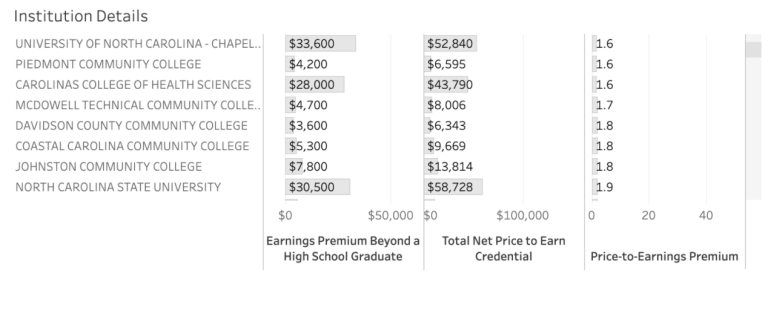Publisher's Note: This post appears here courtesy of
The James G. Martin Center. The author of this post is
Chris West.
Shelling out the time and cash necessary to earn a degree is a sacrifice. For many, the question of "is college worth it?" has a simple answer: "yes." But for others, the answer may not be so clear. A private liberal arts school may look more glamorous than the neighborhood community college, but it also comes with a hefty price tag. How can students determine whether or not their investment of time and money will pay off in the long run?
There may be a way to answer that question. Third Way, a nonprofit that self-identifies as center-left, recently just released a mapping tool that helps evaluate what return on investment-if any-students should expect if they were to earn a degree or a credential from a given institution. Specifically, the Price-to-Earnings Premium (PEP) tool compares the "net price the average student pays out-of-pocket to obtain an academic credential relative to the additional amount they earn by attending that institution in the first place."
The authors of the research, Tosin Akintola, Michael Itzkowitz, and Nicole Siegel based their calculations on publicly available data from the U.S. Department of Education. Itzkowitz notes:
To determine how much students pay out of pocket, we look at how much it typically costs them to attend an institution after all scholarships and grants are taken into account, or their total annual net cost. Rather than only assessing whether students are earning enough to pay down their educational debt-as the Gainful Employment regulations did-a net price assesses how much students actually paid to finance their postsecondary endeavors, whether that's through federal loans, self-financing, or both.
The tool is equipped with an interactive map, clear explanations of the authors' methodology, and a number of helpful comparative data dashboards. Their simple formula calculates a "price-to-earnings premium," i.e., how many years it takes the average student from a given institution to recoup their educational costs.

(Source: Third Way)
Perhaps the database's most informative feature is the three columns of institution-level data that lists 1) "earnings premium beyond a high school graduate," i.e., how much more on average a student with a degree from the institution earns over someone with a high school diploma, 2) "total net price to earn a credential," and 3) the "price-to-earnings-premium." (See image below.)

(Source: Third Way)
In North Carolina, some institutions are well-worth the investment.
The following five schools had the best price-to-earnings premiums, i.e., they took the least amount of time to recoup net costs:
- Cleveland Community College (0.1 years)
- Wayne Community College (1.0 years)
- Fayetteville Technical Community College (1.2 years)
- Halifax Community College (1.2 years)
- Elizabeth City State University (1.5 years)
Perhaps not surprisingly, most of these schools are community colleges. The total costs of an education at these schools are generally very low, which is likely why students are able to recoup their investment so quickly.
The "total net price to earn a credential" at Cleveland Community College (CCC), for example, is only $168. The average student who makes that investment at CCC can expect to earn $2,500 more than the average high school graduate. This return on investment, coupled with the fact that it takes virtually no time to recoup the costs, makes CCC a very low-risk option for students hoping for a pay-bump.
However, although attending some community colleges definitely pays off, not all community colleges are created equal. Four-year universities are generally more expensive but even some community colleges can come with a significant price tag.
Of the 113 higher education institutions in North Carolina that were included in the database, several community colleges were among the schools with the worst PEPs.
For instance, the total net price to earn a credential at Bladen Community College is $22,572 but the average earnings past a high school graduate are only $1,400, making the price-to-earnings premium a dismal 16.1. Although taking 16 years to earn one's investment back is not ideal- taking 51 years is clearly worse: Livingston College, a four-year institution, has the same earnings past a high school graduate as Bladen Community College but costs a shocking $71,396 to earn a credential.
Some institutions-Robeson Community College, Martin Community College, College of the Albemarle, Leon's Beauty School, and Paul Mitchell The School of Gastonia-had no return on investment.
Of all the four-year state schools, it took the least amount of time to recoup the cost of a degree at Elizabeth City State University (1.5 years). The cost of a credential at ECSU is $13,004, but the earnings beyond the average high school graduate is $8,400. However, UNC-Chapel Hill graduates recoup their costs in almost the same amount of time (1.6 years), but make significantly more than ECSU graduates-with "beyond high school" earnings of $33,600.
Some of the most expensive schools in the state scored fairly well. Expensive schools like High Point University, Elon University, Duke University, and Methodist University all charge more than $30,000 per year but take less than ten years to earn their worth back.
Some schools take longer to pay back. Two schools, Bladen Community College and St. Augustine's University are likely to take 15-20 years to see a return on investment. Others took upwards of 20 years to see any return, such as Warren Wilson College, Tri-County Community College, and Brunswick Community College.
The institutions with little-to-no rate of return share no apparent geographic commonalities. Some are community colleges and others are private liberal arts colleges.
Admittedly, the PEP measure has a few limitations. Users must keep in mind that the PEP only tells you how long it takes to recoup your investment, not the amount you will make once that investment has paid for itself. Nobody expects a three thousand dollar degree from Pamlico Community College to gross the same amount as a one-hundred thousand dollar degree from Duke University.
Another important consideration to keep in mind is that this tool does not account for the opportunity costs of earning a degree. These institutions take anywhere from two to four years to earn a credential, a time during which students are generally either unemployed or significantly underemployed.
Nevertheless, Third Way's research can be a useful tool for students when deciding what institution to attend. According to the calculations based on the data, most of the four-year university institutions in North Carolina take somewhere around 5-10 years to recoup the cost of attendance whereas most community colleges take 0-5 years. Even many of the institutions with a higher price tag like Duke and Elon take only a few years to pay off and once the final payment is made, graduates are earning significantly higher amounts than their counterparts who are community college graduates.
Of course, North Carolina should continue to implement policies and institutional strategies to reduce the growing costs of higher education. And nobody is arguing that we should forget trying to improve curricula and the overall education quality that is being offered on our campuses, both public and private. However, overall, at least in terms of return on investment, the research done by Third Way indicates that many North Carolina Colleges and Universities appear to be sound options for high achieving students.
Chris West is a graduate student at Duke University Divinity School. Previously, Chris spent 2018-2019 as a Martin Center policy fellow.
























